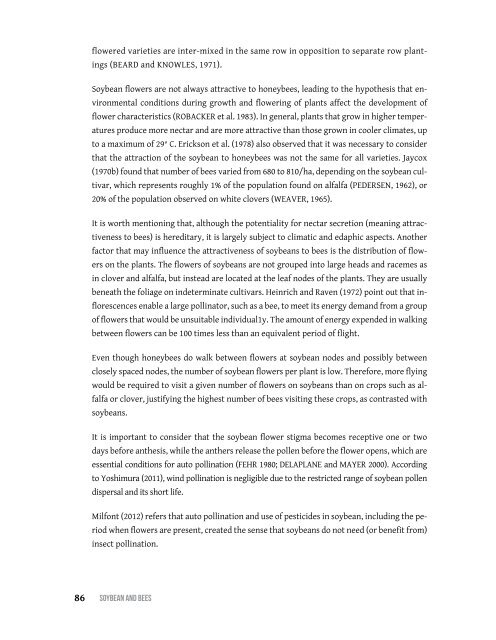Soybean and Bees
Create successful ePaper yourself
Turn your PDF publications into a flip-book with our unique Google optimized e-Paper software.
flowered varieties are inter-mixed in the same row in opposition to separate row plantings<br />
(Beard <strong>and</strong> Knowles, 1971).<br />
<strong>Soybean</strong> flowers are not always attractive to honeybees, leading to the hypothesis that environmental<br />
conditions during growth <strong>and</strong> flowering of plants affect the development of<br />
flower characteristics (Robacker et al. 1983). In general, plants that grow in higher temperatures<br />
produce more nectar <strong>and</strong> are more attractive than those grown in cooler climates, up<br />
to a maximum of 29° C. Erickson et al. (1978) also observed that it was necessary to consider<br />
that the attraction of the soybean to honeybees was not the same for all varieties. Jaycox<br />
(1970b) found that number of bees varied from 680 to 810/ha, depending on the soybean cultivar,<br />
which represents roughly 1% of the population found on alfalfa (Pedersen, 1962), or<br />
20% of the population observed on white clovers (Weaver, 1965).<br />
It is worth mentioning that, although the potentiality for nectar secretion (meaning attractiveness<br />
to bees) is hereditary, it is largely subject to climatic <strong>and</strong> edaphic aspects. Another<br />
factor that may influence the attractiveness of soybeans to bees is the distribution of flowers<br />
on the plants. The flowers of soybeans are not grouped into large heads <strong>and</strong> racemes as<br />
in clover <strong>and</strong> alfalfa, but instead are located at the leaf nodes of the plants. They are usually<br />
beneath the foliage on indeterminate cultivars. Heinrich <strong>and</strong> Raven (1972) point out that inflorescences<br />
enable a large pollinator, such as a bee, to meet its energy dem<strong>and</strong> from a group<br />
of flowers that would be unsuitable individual1y. The amount of energy expended in walking<br />
between flowers can be 100 times less than an equivalent period of flight.<br />
Even though honeybees do walk between flowers at soybean nodes <strong>and</strong> possibly between<br />
closely spaced nodes, the number of soybean flowers per plant is low. Therefore, more flying<br />
would be required to visit a given number of flowers on soybeans than on crops such as alfalfa<br />
or clover, justifying the highest number of bees visiting these crops, as contrasted with<br />
soybeans.<br />
It is important to consider that the soybean flower stigma becomes receptive one or two<br />
days before anthesis, while the anthers release the pollen before the flower opens, which are<br />
essential conditions for auto pollination (Fehr 1980; Delaplane <strong>and</strong> Mayer 2000). According<br />
to Yoshimura (2011), wind pollination is negligible due to the restricted range of soybean pollen<br />
dispersal <strong>and</strong> its short life.<br />
Milfont (2012) refers that auto pollination <strong>and</strong> use of pesticides in soybean, including the period<br />
when flowers are present, created the sense that soybeans do not need (or benefit from)<br />
insect pollination.<br />
86 SoybeAn <strong>and</strong> bees


